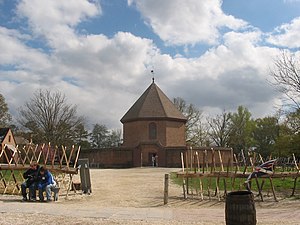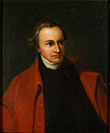Gunpowder Incident
| Gunpowder Incident | |||||||
|---|---|---|---|---|---|---|---|
| Part of the American Revolutionary War | |||||||
 The powder magazine in Williamsburg from which the gunpowder was removed | |||||||
| |||||||
The Gunpowder Incident (or Gunpowder Affair) was a conflict early in the American Revolutionary War between Lord Dunmore, the Royal Governor of the Colony of Virginia, and militia led by Patrick Henry. On April 21, 1775, one day after the Battles of Lexington and Concord (and well before news of those events reached Virginia), Lord Dunmore ordered the removal of the gunpowder from the magazine in Williamsburg, Virginia to a Royal Navy ship.
This action sparked local unrest, and militia companies began mustering throughout the colony. Patrick Henry led a small militia force toward Williamsburg to force return of the gunpowder to the colony's control. The matter was resolved without conflict when a payment of £330 was made to Henry. Dunmore, fearing for his personal safety, later retreated to a naval vessel, ending royal control of the colony.
Background
Military tensions began to rise in the
In early 1775, Virginians began to organize militia companies and seek out military supplies (weapons, ammunition, and gunpowder) to arm and equip them.
Removing the gunpowder

On the early morning of April 21, 1775 Royal Navy sailors went to the Williamsburg powder magazine, loaded fifteen half barrels of powder into the governor's wagon, and transported it to the eastern end of the
Unrest however persisted in Williamsburg and spread throughout the countryside. After a second crowd was convinced to disperse by Patriot leaders, Dunmore reacted angrily, warning on April 22 that if attacked, he would "declare Freedom to the Slaves, and reduce the City of Williamsburg to Ashes."[6] He also told a Williamsburg alderman that he had "once fought for the Virginians" but "By God, I would let them see that I could fight against them."[8]

By April 29, militia mobilizing in the countryside had learned of the battles at Lexington and Concord. Nearly 700 men mustered at Fredericksburg, and decided to send a messenger to Williamsburg to assess the situation before marching on the capital. Peyton Randolph advised against violence, and George Washington, a longtime leader of the Virginia militia, concurred. In response to their advice, the Fredericksburg militia voted by a narrow margin not to march.[9] However, militia from other parts of the colony did march to Williamsburg. The Hanover County militia, led by Patrick Henry, voted on May 2 to march on Williamsburg. Henry dispatched a small company to the home of Richard Corbin, who was the Deputy Collector of the Royal Revenue in Virginia, in a bid to force him to pay for the powder from Crown revenue in his possession; the remainder of the Hanover County militia, numbering about 150, marched toward Williamsburg, arriving about 15 miles (24 km) away on May 3.[10] That day Dunmore's family escaped Williamsburg to Porto Bello, Lord Dunmore's hunting lodge on the York River, and from there to HMS Fowey, lying at anchor in the York River.[11]
Corbin was not at home—he was in Williamsburg, meeting with Dunmore.
Aftermath

The incident burnished Henry's reputation while worsening Dunmore's popularity.
Dunmore continued to make vigorous attempts to regain control of the colony, but after
See also
- Powder Alarm, a similar episode in Massachusetts
- American Revolutionary War §Early Engagements. The Gunpowder incident placed in sequence and strategic context.
Notes
- ^ Russell, pp. 45–46
- ^ Richmond, p. 6
- ^ a b Russell, p. 48
- ^ a b Selby and Higginbotham, p. 1
- ^ Williamson, p. 54
- ^ a b c Russell, p. 52
- ^ Selby and Higginbotham, p. 2
- ^ Selby and Higginbotham, p. 3
- ^ a b c Russell, p. 53
- ^ a b Selby and Higginbotham, p. 4
- JSTOR 1921010.
- ^ a b c Selby and Higginbotham, p. 5
- ^ Vaughan, p. 88
- ^ Vaughan, p. 89
- ^ Colonial Williamsburg Magazine Archived 2005-12-03 at the Wayback Machine
- ^ Selby and Higginbotham, pp. 41–43
- ^ Selby and Higginbotham, p. 44
- ^ Russell, pp. 68–76
- ^ Selby and Higginbotham, pp. 52,121
References
- Richmond, Robert P (1971). Powder Alarm 1774. Princeton, NJ: Auerbach. OCLC 162197.
- Russell, David Lee (2000). The American Revolution in the Southern colonies. Jefferson, NC: McFarland. OCLC 248087936.
- Selby, John E; Higginbotham, Don (2007). The Revolution in Virginia, 1775–1783. Williamsburg, VA: Colonial Williamsburg. OCLC 124076712.
- Vaughan, David (1997). Give Me Liberty: the Uncompromising Statesmanship of Patrick Henry. Nashville, TN: Cumberland House Publishing. OCLC 36372369.
External links
- "Primary Documents Relating to the Seizure of Powder at Williamsburg, VA, April 21, 1775"
- Old Virginia Gazette article on the Gunpowder Incident
- Proclamation against Patrick Henry
- Colonial Williamsburg – Magazine (including the Gunpowder Incident)

